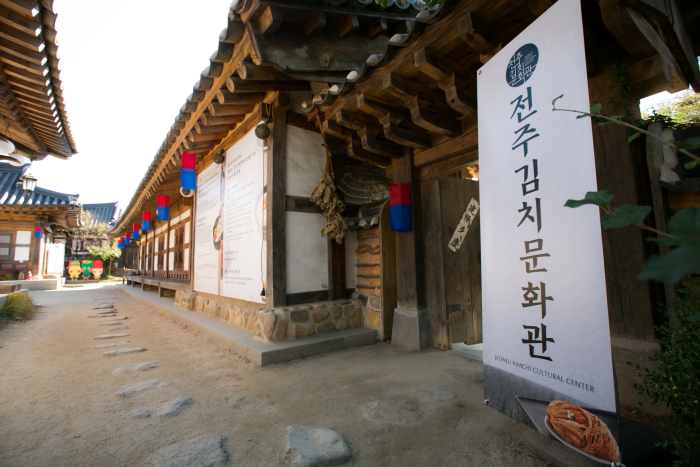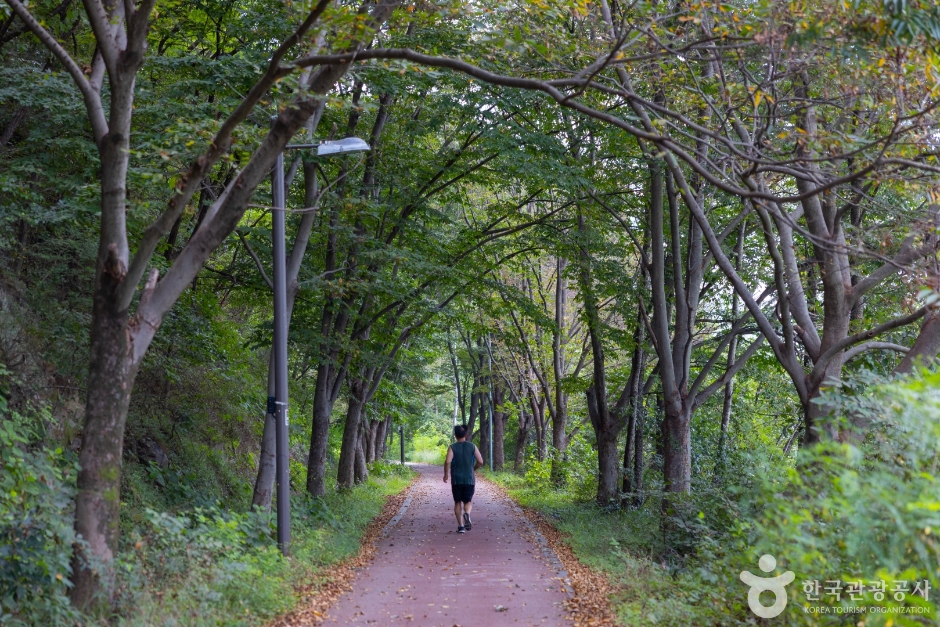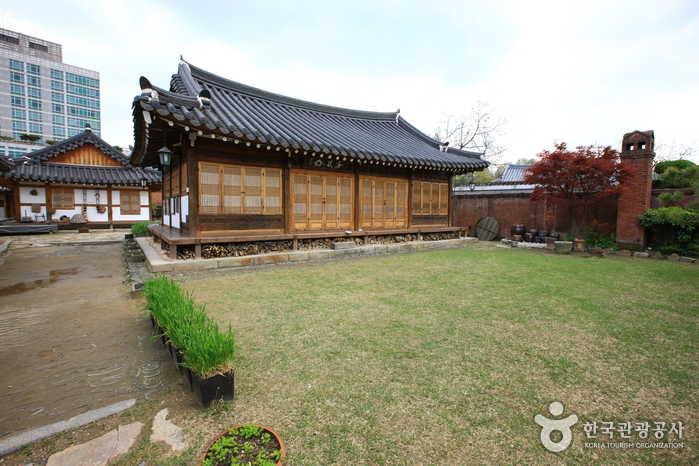Jeonggahanog [Korea Quality] / 정가한옥 [한국관광 품질인증]
12.3 Km 176 2024-04-07
78-3, Girin-daero, Wansan-gu, Jeonju-si, Région Jeonbuk
+82-10-9934-1300
Jeongga Hanok is a space where the traditional beauty of hanok and the modern comfort co-exists. The newly built Hanok is neat and pleasant. When you enter the small cobbled yard, the porch and the eaves will welcome you, and you’ll find that the rooms are filled with delicate wood fragrance. The interior is furnished with Korean cypress trees and red clay. In particular, the Cypress Tree room is all made of cypress trees, from the walls to the ceiling, making guests feel like they are lying in a forest. Maple Room and Ginkgo Tree Room, meanwhile, have attics.
Jeongga Hanok faces Jeonju Hanok Village with the Girin-daero in the middle. Hanok Village is just across the road. Major attractions such as Gyeonggijeon, Jeondong Catholic Cathedral, and Jeonjuhyanggyo Confucian School are all within walkable distance. Omokdae, which offers an unhindered view of Hanok Village, is located over the pedestrian overpass. Jaman Mural Village, famous for colorful mural and cozy cafes, is about 300 meters away and a great spot for selfie lovers.
Centre culturel de kimchi dans le village hanok de Jeonju (전주한옥마을 전주김치문화관)
12.3 Km 5262 2024-04-07
29, Eojin-gil, Wansan-gu, Jeonju-si, Région Jeonbuk
+82-63-287-6300
Le centre des expériences de vie traditionnelles de jeonju est un guest house situé dans le village de hanok de Jeonju. Les visiteurs peuvent y vivre une expérience unique de la vie en habitat traditionnel. Le centre était à l’origine une résidence de noble construite durant la dynastie Joseon (1392-1910) aujourd’hui reconstruite, elle accueille de nombreux visiteurs notamment des étrangers qui peuvent y découvrir le côté traditionnel de la Corée. L’habitat a perdu de son côté vetuste mais y a gagné en comfort. Les visiteurs peuvent s’amuser à découper le bois pour alimenter le système traditionnel de chauffage. Il s’agit du ondol, un système de chauffage qui irradie l’ensemble du sol par dessous. Les visiteurs dorment sur des petits matelas à même le sol où il est bon de se prélasser durant les journées froide d’hiver.
Dans ce guest house, les hôtes peuvent également apprendre des chansons traditionnelles, y prendre le thé, ou encore faire du vélo autour de la propriété. Les repas sont compris dans le prix de l’hébergement.
Musée de l'Alcool Traditionnel Coréen de Jeonju (전주 전통술박물관)
12.3 Km 5582 2024-04-07
74, , Wansan-gu, Jeonju-si, Région Jeonbuk
+82-63-287-6305
Découvrez la gloire de l’alcool traditionnel coréen dans ce musée ! Vous pouvez voir les outils et machines utilisés pour la fabrication, ainsi que des expositions sur le thème de l’alcool traditionnel. Les zones les plus intéressantes du musée sont considérées commé étant la salle de préparation d’alcool et la salle de fermentation. Grâce aux enceintes disposées dans ces deux salles, vous pourrez entendre les sons amplifiés que l’alcool émet pendant le procédé de fermentation. Vous pourrez également profiter des arômes séduisants de la liqueur traditionnelle coréenne. Les premiers et troisièmes samedis du mois, vous pourrez vous faire la main à la fabrication et pendant les seconds et quatrièmes, il vous sera possible de participer à une dégustation traditionnelle.
Route Baramsseoneun-gil (바람쐬는길)
12.3 Km 0 2024-04-08
21, Baramsseoneun-gil, Wansan-gu, Jeonju-si, Région Jeonbuk
La route Baramsseoneun-gil désigne la route entre Jeonju Eco Museum et le tunnel Hanbyeok. Le nom de la route provient du ventqui souffle le long de la route, faisant de l'endroit un endroit conseillé pour les promenades.
La route a également été choisie par le KTO comme l'un des meilleurs chemins à parcourir avec son animal de compagnie. On trouve aussi une station de prêt de vélo situé le long du chemin. Le tunnel Hanbyeok est connu en tant que lieu de tournage du drama "Twenty-five Twenty-one (2022)".
GaEunChae [Korea Quality] / 가은채 [한국관광 품질인증]
12.3 Km 429 2024-04-07
68-13, Hanji-gil, Wansan-gu, Jeonju-si, Région Jeonbuk
+82-10-6345-5267
Gaeunchae is a Handol guesthouse located in Jeonju Hanok Village. Among the four Hanok buildings built by a construction company in 1969, two are being operated as a Gaeunchae guesthouse. While turning it into a lodging place, everything related to a private house was removed, but the original form of the building was revived for guests to feel the beauty of the traditional Hanok.
Jeonju Master's Crafts Center, Jeonju Korean Traditional Wine Museum, Seunggwangjae, Dakjongi Hanji Dolls Workshop, etc. are just a stone's throw away. In particular, the pretty alleys are part of the Hanok Village alley tour course 1 operated by Jeonju City.
In the middle of the yard of Gaeunchae are stones refined by hand years ago, including Macheon Stone, Sago Stone, Goheung Stone, Hwangdeung Stone, etc; the southern yard is paved with flat stones such as old granite, bakseok, and mica. Traditional room doors fitted without using any nails and traditional windows add to the gracefulness of Hanok.
Samrockhon [Korea Quality] / 삼락헌 [한국관광 품질인증]
12.3 Km 7345 2024-04-07
47-8, Eunhaeng-ro, Wansan-gu, Jeonju-si, Région Jeonbuk
+82-10-7799-7358
Samllakheon is located in the center of Jeonju Hanok Village which is the highlight of traveling in Jeonju. Samllakheon has been opened newly by the owner husband and wife who are running Bugyeongdang, a lodging in traditional Korean style house. The building of Samllakheon used to be the etiquette training center of Jeollabuk-do Province, and its size is much larger and more magnificent than ordinary houses and its style is very antique. The arrangement of the houses, the pillars, rafters, crossbeam and the ridge of the roof are clearly different from those of ordinary houses. The garden covered with pebbles and rocks and the well-tended flower bed are also worth seeing.
The rooms are composed of the five rooms of Spring, Summer, Fall, And, & Winter. Every room has a duplex attic under the high ceiling and a warm and clean restroom. The guests can help themselves with coffee, tea, toast, etc. for breakfast from the communal mini kitchen. The guests of Samllakheon can have 50% discount on Korean traditional clothes and 30% discount on rent of electric bike. It is also possible to experience traditional culture including making Injeolmi rice cake, Korean paper art, pottery and fragrant purse by making a reservation in advance.
The owners of the house can give information on Jeonju Hanok Village, many other tourist attractions and famous restaurants in Jeonju area. Major tourist attractions within walking distance are Jeondong Catholic Church, Gyeonggijeon, Gyodong Art Center, Choi Myung-Hee Literature Center, Omokdae, Jeonju Hyanggyo, Pungnammun Gate nd Nambu Market & Youth Mall.
Bu Yong Heon [Korea Quality] / 부용헌 [한국관광 품질인증]
12.4 Km 11203 2024-04-07
149-3, Hyanggyo-gil, Wansan-gu, Jeonju-si, Région Jeonbuk
+82-10-8646-0964
Buyongheon is located in Jeonju Hanok Village. Precisely speaking, Buyongheon is the very next door to Jeonju Hyanggyo (Confucian Temple and School). Across the alley are Jeonju Hyanggyo Culture Center and Wanpanbon Culture Center. If you walk a few more steps, you will reach Jeonju Hanbyeok Culture Center where you can see various performances and experience the culture and foods of Jeonju. Omokdae can be seen from the garden of Buyongheon. Across the Jeonjucheon Stream is the National Intangible Heritage Center.
The beginning of Buyongheon is deeply related with Jeonju Hyanggyo. In around 1935, the local bureaucrats lived around the Hyanggyo after building 12 houses one after another. Most of them came from rich families. These collective houses were called Buyong Houses, which meant rich houses. The name Buyongheon originated from Buyong Houses. The rooms of Buyongheon are composed of Toenmaru Bang, Daecheong Maru Bang, Large Daecheong Maru Bang and Big Sarangchae. The interior of the rooms looks neat with the beauty of blank space as they excluded unnecessary decorations. Carefully prepared breakfast is served upon request made in advance. Visitors can also experience traditional culture such as traditional etiquette education and Korean paper art.
In fall, the yellow leaves of the ginkgo tree in the garden of Jeonju Hyanggyo lights up the roof of Buyongheon. It is recommendable to walk along the Jeonjucheon Stream and take pictures of the colorful murals and the cafes in the Jaman Mural Village located on the left sie of the Hanok Village. It takes 15 minutes from Jeonju Station and 10 minutes from Jeonjuu Express Bus Terminal to Buyongheon by taxi.
Ihwa Gotaek [Korea Quality] / 이화고택 [한국관광 품질인증/Korea Quality]
12.4 Km 11 2024-04-07
91, Hanji-gil, Wansan-gu, Jeonju-si, Région Jeonbuk
This “ㄱ”-shaped hanok (traditional Korean house) building, standing to the right-hand side of the gate, is an old house with a history of more than 120 years that was transplanted to its present site from its original location in Buan’s local Confucian school in Jeollabuk-do. The building to the left across the courtyard is a “ㄷ”-shaped building with a history of about 70 years. The buildings at Ihwa Gotaek stick to the classics of hanok architecture, featuring the trio of open wooden-floor spaces called numaru, toenmaru, and jjongmaru.
There are 8 rooms in total, 1 four-person room with eight maximum occupancy, and 7 two-person rooms with maximum occupancy of four. All rooms have their own attached restrooms. Guests are served with complimentary seasonal refreshments, either a sweet rice punch (sikhye) or shaved ice with sweetened red beans (pat bingsu) made in-house, and for breakfast guests have a wonderful spread that includes bibimbap, rice cake soup, black sesame porridge, and bean-powder-coated rice cake, served in traditional bronze tableware. Guests can also place their reservations for traditional cultural programs like pansori (epic chant), tea ceremony, natural dye, and Korean paper art, and enjoy a discount of 30% in hanbok (traditional Korean clothes) rental.
Dongnagwon (동락원)
12.4 Km 5946 2024-04-07
33-6, Eunhaeng-ro, Wansan-gu, Jeonju-si, Région Jeonbuk
+82-63-285-3490
La maison Dongnagwon est une bâtisse représentative du village de Hanok de Jeonju, offrant l’opportunité d’effectuer un ‘Hanok Stay’ (passer la nuit dans une maison traditionnelle coréenne) et de vivre la vie coréenne traditionnelle. Affiliée au collège Kijeon de Jeonju, Dongnagwo est aussi un lieu de commémoration à la mémoire de W. M. Junkin, venu en Corée en 1892 en tant que missionnaire, et originaire de l’église presbytérienne du sud des Etats-Unis. Dongnagwon est une structure hanok traditionnelle consistant en un Anchae (bâtiment principal), Sarangchae (maison détachée) et Haengnangcha (maison des domestiques). Elle représente parfaitement l’agencement des vieilles maisons hanok de Jeonju à l’époque où W. M. Junkin effectuait ses travaux religieux dans la région. Les visiteurs de Dongnagwon ont la possibilité de s’essayer à la vie traditionnelle coréenne en passant une nuit dans une chambre du hanok, mais également en découvrant la musique traditionnelle, l’artisanat local et la dance. De plus, Dongnagwon propose également l’hébergement de groupes ou l’accueil lors de l’organisation de conférences, séminaires et évènements familiaux. Pour les groupes supérieurs à 30 personnes, il est possible de louer le site entier (couvrant toutes les zones du site, incluant Seungdokdang, Seunghwadang, Cheongyuje, et le jardin de devant).
Bukyungdang [Korea Quality] / 부경당 [한국관광 품질인증]
12.4 Km 225 2024-04-07
99-5, Hanji-gil, Wansan-gu, Jeonju-si, Région Jeonbuk
+82-10-5327-8736
Located at the heart of the Jeongju Hanok Village, Bugyeongdang is a beautiful traditional 60-year old Hanok.
Traditional floor, roof tiles, and jar stands next to stone walls, while small garden and flower beds reflect the architect couple's attentive hands. As a Hanok with one of the prettiest gardens in Jeonju Hanok Village, it is a good place to appreciate the garden flowers and enjoy the unique laid-back atmosphere of Hanok while sitting on the floor. The place is close to major tourist attractions including Imokdae, Gyeonggijeon, Jeondong Catholic Cathedral, and Hyanggyo.
The owner, who was born and raised in the Jeonju Hanok Village, describes must-go sites like a tour guide and introduces undiscovered great restaurants or things-to-do to the guests. As the owner, who had long been engaged in architecture, takes care of the Hanok, the building always stays clean and in good condition.
In the shared kitchenette, guests can prepare simple breakfast for themselves with the dishes and cups made by the wife of the owner herself. Luggage storage services before check-in and after check-out, and description of tourist attractions are provided.
![Jeonggahanog [Korea Quality] / 정가한옥 [한국관광 품질인증]](http://tong.visitkorea.or.kr/cms/resource/62/2594362_image2_1.jpg)



![Samrockhon [Korea Quality] / 삼락헌 [한국관광 품질인증]](http://tong.visitkorea.or.kr/cms/resource/02/2596602_image2_1.jpg)
![Bu Yong Heon [Korea Quality] / 부용헌 [한국관광 품질인증]](http://tong.visitkorea.or.kr/cms/resource/94/2596794_image2_1.jpg)
![Ihwa Gotaek [Korea Quality] / 이화고택 [한국관광 품질인증/Korea Quality]](http://tong.visitkorea.or.kr/cms/resource/50/2707550_image2_1.jpg)

![Bukyungdang [Korea Quality] / 부경당 [한국관광 품질인증]](http://tong.visitkorea.or.kr/cms/resource/29/2593529_image2_1.jpg)
 Français
Français
 한국어
한국어 English
English 日本語
日本語 中文(简体)
中文(简体) Deutsch
Deutsch Español
Español Русский
Русский